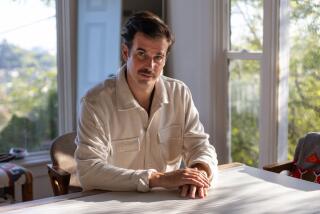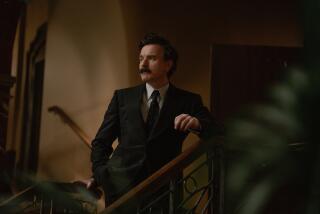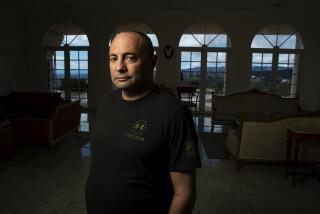Traveling in Style : The Insiderâs Moscow : The Real Russia Begins Where Intourist Stops
No one in the new Soviet Union, not even Intourist guides, tries any longer to pretend. So the people on the package tours this summer (a day at the Hermitage, a day at the Kremlin, a night at the Bolshoi) will mercifully be spared hearing how many million cubic meters of housing the state constructed last year and how lucky the workers are to pay so little for it. Intourist guides, like anyone else, are more likely to complain that thereâs no food in the stores. If they work in one of the outer republics, they may well be quiet separatists.
But some things have not changed. Intourist is still the state tourism monopoly. Intourist still herds its clients in organized groups, moving from foreignersâ ghetto to foreignersâ ghetto (the hotels, restaurants and shops that are not open to Soviet citizens), segregating them from the population. To be fair to Intourist, this no longer seems like a device to prevent foreigners from contaminating the locals with dangerous ideas. Itâs more a matter of knowing that the kind of hotel, bus or waiting room that the average Soviet citizen puts up with every day would send the average dollar-bearing tourist straight to Finland.
For the record:
12:00 a.m. June 2, 1991 For the Record
Los Angeles Times Sunday June 2, 1991 Home Edition Part A Page 3 Column 6 Metro Desk 1 inches; 29 words Type of Material: Correction
Moscow landmark--In todayâs issue of Traveling in Style magazine, a photo caption on Page 28 incorrectly identifies a building as âthe Kremlin towers.â The photo is of St. Basilâs Cathedral in Red Square.
The result is that many visitors donât see much more of the Soviet Union than they could spot over the shoulders of the network-TV correspondents doing stand-ups in Red Square.
Breaking free of this ghetto and searching out real Soviet life requires some initiative and ingenuity. There are occasionally enchanting outdoor spaces in Russia. On a clear, cold day in January, after a snowfall, you can drive out of Moscow on the Mozhaisk Highway to the writersâ colony of Peredelkino, park the car and set off into the woods on skis, listening to the stillness. On a warm day in June, you can take the same drive, stopping near the bright, golden domes of the Cathedral of the Transfiguration, the village church. Next to the church is a long, shaded graveyard. You can wander through it until you reach Boris Pasternakâs grave, with his profile sculpted on the tombstone. It will, invariably, be strewn with flowers, and if you are lucky, someone will be sitting on the bench at Pasternakâs feet, ready to recite his verses.
In other countries, a traveler could rub shoulders with real people in cafes and restaurants. Not in the Soviet Union. Suffice it to say that when someone asks me what to take on a first trip to Russia, I recommend lots of packages of water-soluble Ultra Slim-Fast; if I had to name a favorite Moscow restaurant, it would be the new Pizza Hut on Gorky Street, where I usually dine alone.
Once in a while, a state restaurant can be amusing, if you donât mind bribing an oafish old doorman to get in, dealing with indifferent food and waiters and watching men dance with men and women dance with women to music from a very loud band. Since perestroika, some cooperative businessmen have opened private restaurants. A few of them start out well, but all seem to degenerate quickly into places with ridiculous prices and separate rooms for foreigners with hard currency. My Soviet friends donât feel comfortable in them. For one thing, they realize that the dollars I am spending on dinner would fund the average retireeâs annual pension. And Russians just arenât cafe people. Read âWar and Peace.â Long before Communism, they socialized, for the most part, in each otherâs homes, and they still do.
To explore the real Soviet Union, you have to see it the way Tolstoy saw Russia--from inside peopleâs homes. Fortunately, this is getting easier to do. Most of the Soviet nationalities, particularly the Russians, are by nature gregarious and hospitable. Now they donât have to be courageous to show it. They generally like to practice their English and will gratefully applaud your efforts to speak their language. There are lots of ways to get to know them. You might, for instance, contact the Hebrew Immigrant Aid Service or an Armenian church for the names of some recent Soviet immigrants in your area. Call them up; they will inevitably have a long list of friends and relatives back home and will ask you to serve as a courier for little gifts for each of them.
A handful of travel companies recently began arranging âbed-and-breakfastâ stays in private homes, capitalizing on the opportunity to establish essentially private cooperatives that may compete with Intourist. But because they are so new their reliability has yet to be proved.
Or travel within the country by train, book a second-class (four-bunk) berth and bring along a bottle. By the time the train arrives, you will have three new friends. Donât, however, get friendly with anyone who meets you inside an Intourist hotel. Such people are professionals, of one kind or another.
Once inside a Soviet citizenâs home, the countryâs secrets open up to you. Ever wonder why television news always shows empty Soviet grocery store shelves but rarely shows thin Russians? So did I, until one evening in the home of some Armenians in Rostov-on-Don in southern Russia. When the time came to cook supper, my hostess pushed aside the dining table, pulled up a trap door and descended into a whitewashed storage cellar, dug out by her father a generation ago, where her family kept its larder of jarred vegetables, sausage and other food, bought or grown in the summer months and stored for the long winter.
I first glimpsed the real Soviet Union in a room in someone elseâs apartment--to be precise, the kabinet (âstudyâ) of Roy Medvedev, the historian who, when I first met him, was a dissident. To get to Royâs, you have to drive out the Leningrad Highway to the northwest end of town and find a five-story building of the type that Muscovites refer to as a khrushchoba. Itâs a pun on trushchoba, the Russian word for âslum,â because it and thousands of buildings like it were erected hastily and cheaply when Nikita Khrushchev was in power. Roy lives on the fifth floor, and there is no elevator. I can always tell how far out of shape I am by how much I am puffing when I ring his doorbell.
Inside the door, there is a corridor and a rack crammed with coats. You hang your coat up, take off your shoes and step into a pair of guest slippers. There is a medium-sized room to the left that serves as a bedroom and sitting room, but I have rarely been in it. Royâs kabinet is a step or two farther down the hall and to the right. Itâs a snug little room, shaped like a shoe box and not much larger. A few houseplants grasp at the light that comes in through the one small window. Royâs desk and bookshelves take up most of the floor space. The basic tools of his trade--an old manual typewriter, a telephone and a shortwave radio--sit on the desk. The bookshelves stretch to the ceiling, crammed with Soviet classics and his own works, on Stalin, Khrushchev and others, translated into many languages. When you sit down, there isnât much room between Royâs knees and yours.
If Royâs wife is home, she will offer tea and cookies, but, of course, you donât go for the refreshments. You go for the conversation. Conversation is still one of the glories of Soviet culture. At Royâs, it was and is almost invariably about politics. A former schoolteacher, he delivers his information and opinions in the clearest, most understandable Russian I have ever heard; I realized I would be able to get along in Russian while listening to him at our first meeting at the end of 1982. In those days, Roy had been expelled from the Party, but he still had friends and contacts within it. He knew something of what went on in inside the pre-glasnost Kremlin, and if you asked him about it, he would tell you what he knew.
In that small room, respect for the truth reigned, which is rare enough anywhere but was especially so in Moscow then. And it was burnished by courage. Sitting in his kabinet, Roy, at my request, once gave me an interview in which he correctly assessed the election of Konstantin Chernenko as a reversion to the stagnation of the late Brezhnev years. He knew that by doing so he flirted with personal disaster, but he told the truth as he saw it. Sure enough, after the interview was published, plainclothesmen showed up at his door and, for a year, kept foreigners from calling on him. I was afraid I would be expelled, and I was prepared to stop visiting him. Roy, who was so much more vulnerable, refused to be intimidated. He simply took to meeting in a nearby park, quietly speaking his mind when asked and continuing to operate as if both he and the police believed in the flowery statements of citizensâ rights in the Soviet constitution.
Nowadays, Roy is back in the Party and, amazingly, a member of its Central Committee and of the Supreme Soviet. When he wants to know whatâs going on in the Kremlin, he can ask Mikhail S. Gorbachev, and he has become a staunch Gorbachev supporter. But when I meet him, I still drive out to the edge of town and talk to him in his kabinet, and he still tells the truth as he sees it. He could, I suppose, use his new rank to get a bigger apartment, closer to the center of town, or an office in the Kremlin area. He hasnât yet, and, rather selfishly, I hope he never does.
Not every Soviet citizen is a Roy Medvedev, but nearly all of them are worth getting to know. You might have to skip the scheduled visit to the Lenin Museum, but Intourist really wonât mind.
GUIDEBOOK: MOSCOW
Getting there: Pan Am offers twice-weekly nonstop flights from New York to Moscow; there are no flights from Los Angeles. Pan Amâs round-trip air fare for the summer, with 21-day advance purchase, is $1,182 to $1,242, depending on departure day; telephone (800) 221-1111. The Soviet airline, Aeroflot, has a direct flight from New York to Moscow five times a week; telephone (212) 332-1050. Visas are necessary.
Where to stay: Three companies offering lodging in Soviet homes are: IBV Bed & Breakfast Systems, 13113 Ideal Drive, Silver Spring, Md. 20906, charges $75 per night ($85 double); telephone (301) 942-3770. Soviet Home and Host, 2445 Park Ave., Minneapolis, Minn. 55404, offers eight-day trips starting at $1,845, which includes round-trip air fare from the United States; telephone (800) 768-4388. American-Soviet Homestays, Route 1, P.O. Box 68, Iowa City, Iowa 52240, offers a variety of trips, one of which is a 17-day stay starting at $2,590, which includes round-trip air fare from Los Angeles States; telephone (800) 876-2048 or (319) 626-2125.
For more information: Intourist, 630 Fifth Ave., Suite 868, New York, 10111; (212) 757-3884.
More to Read
Sign up for The Wild
Weâll help you find the best places to hike, bike and run, as well as the perfect silent spots for meditation and yoga.
You may occasionally receive promotional content from the Los Angeles Times.






